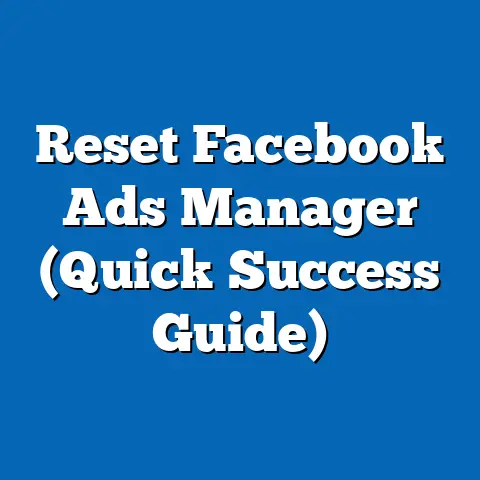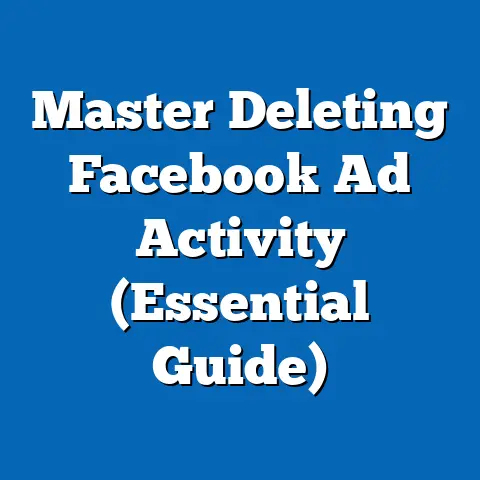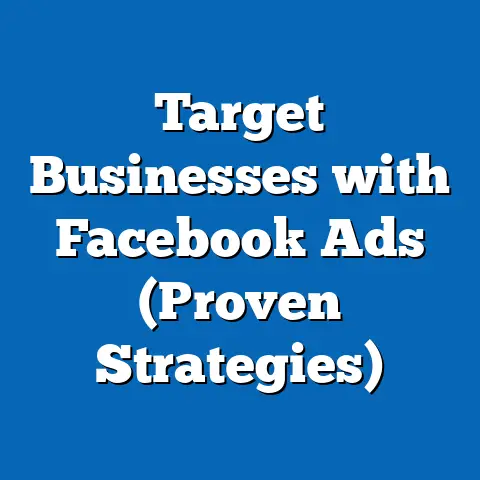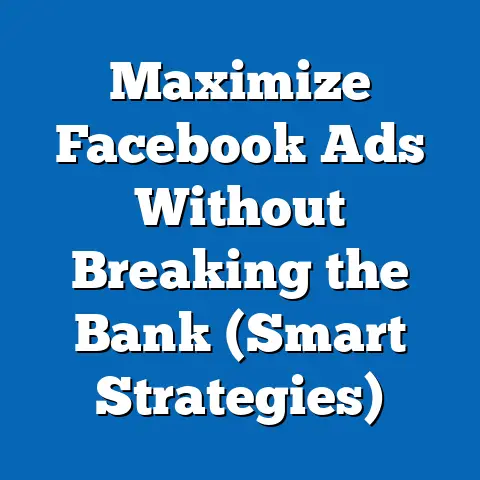Boost Results With Udacity Facebook Ads (Expert Insights)
Facebook advertising. Just the name can send shivers down the spines of some marketers, conjuring images of complex algorithms, endless data streams, and the constant fear of wasting valuable advertising dollars. I get it. I’ve been there. But let me tell you a secret: Facebook Ads, when approached with the right knowledge and strategy, can be incredibly powerful. It’s like having a megaphone that speaks directly to your ideal customer, no matter where they are. And while the platform may seem daunting at first, resources like Udacity are making it easier than ever for businesses of all sizes to unlock its potential.
For years, I struggled to find a consistently profitable strategy, often feeling like I was throwing money into a black hole. Then, I started focusing on understanding the why behind the platform, diving into the data, and learning from experts. That’s when things started to change.
Understanding the Facebook Ads Ecosystem
Before we dive into the specifics of how Udacity can help, let’s lay the foundation by understanding the core components of the Facebook Ads ecosystem. Think of it as learning the rules of the game before you start playing.
At its heart, Facebook advertising is about connecting businesses with the right people. It’s about showing the right message, at the right time, to the people who are most likely to be interested in what you have to offer. This happens through a combination of different ad formats, objectives, and targeting options.
Ad Formats: Facebook offers a variety of ad formats to suit different marketing goals and creative styles. Some of the most common include:
- Image Ads: These are simple, visually appealing ads that feature a single image and accompanying text. They are great for brand awareness and showcasing products.
- Video Ads: Video ads are incredibly engaging and can be used to tell a story, demonstrate a product, or share a testimonial. According to a recent study, video ads receive significantly higher engagement rates than image ads.
- Carousel Ads: Carousel ads allow you to showcase multiple images or videos in a single ad unit, each with its own headline, description, and link. This format is perfect for highlighting different features of a product or telling a multi-part story.
- Collection Ads: These ads are designed for e-commerce businesses and allow users to browse and purchase products directly from the ad.
- Instant Experience Ads: Formerly known as Canvas Ads, these are full-screen mobile ads that load instantly and provide an immersive experience.
Ad Objectives: When creating a Facebook ad campaign, you need to choose an objective that aligns with your marketing goals. Facebook offers a range of objectives, including:
- Awareness: This objective focuses on reaching as many people as possible to increase brand awareness.
- Traffic: This objective aims to drive traffic to your website or landing page.
- Engagement: This objective is designed to increase engagement with your Facebook page, such as likes, comments, and shares.
- Leads: This objective helps you collect leads by using lead forms directly within Facebook.
- App Promotion: This objective is for promoting your mobile app and driving downloads.
- Sales: This objective focuses on driving sales conversions on your website or app.
Targeting Options: This is where Facebook Ads truly shines. The platform offers incredibly granular targeting options, allowing you to reach specific demographics, interests, behaviors, and more. You can target people based on:
- Location: Target people based on their country, region, city, or even specific address.
- Demographics: Target people based on their age, gender, education, relationship status, and more.
- Interests: Target people based on their interests, hobbies, and pages they like.
- Behaviors: Target people based on their online behaviors, such as purchase history, device usage, and travel habits.
- Custom Audiences: Create custom audiences by uploading your customer list, website visitors, or app users.
- Lookalike Audiences: Expand your reach by targeting people who are similar to your existing customers.
The Facebook Ads Manager: The Facebook Ads Manager is your central hub for creating, managing, and analyzing your Facebook ad campaigns. It’s where you’ll set your budget, choose your targeting options, create your ads, and track your performance. It can seem a bit overwhelming at first, but with a little practice, you’ll become a pro in no time.
Takeaway: Understanding the Facebook Ads ecosystem is crucial for creating effective campaigns. By choosing the right ad format, objective, and targeting options, you can reach the right people with the right message and achieve your marketing goals.
The Role of Udacity in Learning Facebook Ads
Now that you have a basic understanding of the Facebook Ads ecosystem, let’s talk about how Udacity can help you master the platform. I’ve always believed that structured learning, combined with hands-on experience, is the key to success in any field, and Facebook advertising is no exception.
Udacity offers a range of courses and Nanodegrees that focus on digital marketing, including specific modules on Facebook Ads. These programs are designed to provide you with the knowledge and skills you need to create and manage successful Facebook ad campaigns.
Structured Learning: Udacity’s courses are structured in a way that makes it easy to learn complex concepts. They break down the information into manageable chunks, and each module builds upon the previous one. This allows you to gradually develop your understanding of the platform and its features.
Hands-On Projects: One of the things I love most about Udacity is its emphasis on hands-on learning. Throughout the courses, you’ll work on real-world projects that allow you to apply what you’ve learned. For example, you might be tasked with creating a Facebook ad campaign for a fictional business or analyzing the performance of an existing campaign. This practical experience is invaluable and will help you develop the skills you need to succeed in the real world.
Real-Life Case Studies: Udacity also incorporates real-life case studies into its courses. These case studies provide you with insights into how successful marketers are using Facebook Ads to achieve their goals. You’ll learn about the strategies they’re using, the challenges they’re facing, and the results they’re achieving. This is a great way to learn from the best and get inspiration for your own campaigns.
Expert Instructors: Udacity’s courses are taught by industry experts who have years of experience in digital marketing and Facebook advertising. They’ll share their knowledge, insights, and best practices with you, and they’ll be available to answer your questions and provide guidance.
Community Support: When you enroll in a Udacity course, you’ll also gain access to a vibrant community of fellow students. This is a great place to ask questions, share your experiences, and get feedback on your work. The community can be a valuable source of support and motivation as you learn Facebook Ads.
I personally know several marketers who have drastically improved their Facebook Ads performance after taking Udacity courses. One friend, Sarah, had been running Facebook Ads for her e-commerce business for years but was never able to achieve consistent results. After completing a Udacity Nanodegree in digital marketing, she completely revamped her approach. She started using more sophisticated targeting options, creating more engaging ad copy, and A/B testing her ads to optimize performance. As a result, she saw a significant increase in sales and a dramatic improvement in her return on ad spend.
Takeaway: Udacity provides a structured, hands-on learning experience that can help you master Facebook Ads. By enrolling in a Udacity course, you’ll gain the knowledge, skills, and confidence you need to create and manage successful Facebook ad campaigns.
Expert Insights on Crafting Effective Facebook Ads
Okay, so you understand the platform and have a solid foundation from Udacity. Now, let’s get into the nitty-gritty of crafting ads that actually convert. This is where expert insights can truly make a difference. Over the years, I’ve learned a few key principles that consistently lead to better results.
Know Your Audience: This sounds obvious, but it’s the most common mistake I see. Don’t just think you know your audience; research them. What are their pain points? What are their aspirations? What kind of language do they use? The more you understand your audience, the better you’ll be able to create ads that resonate with them.
Compelling Ad Copy: Your ad copy is your chance to grab attention and persuade people to take action. Keep it concise, clear, and benefit-driven. Highlight the value you’re offering and use strong calls to action. Don’t be afraid to experiment with different tones and styles to see what works best for your audience.
High-Quality Visuals: Visuals are crucial for capturing attention on Facebook. Use high-quality images or videos that are relevant to your ad copy and target audience. Make sure your visuals are visually appealing and communicate your message effectively.
A/B Testing: Never assume that you know what will work best. Always test different versions of your ads to see what performs best. Test different headlines, images, ad copy, and calls to action. Use the data you collect to optimize your campaigns and improve your results.
Clear Calls to Action: Tell people exactly what you want them to do. Use clear and concise calls to action, such as “Shop Now,” “Learn More,” or “Sign Up Today.” Make it easy for people to take the next step.
Relevance is Key: Facebook’s algorithm rewards ads that are relevant to the user. Make sure your ads are targeted to the right audience and that your ad copy and visuals are consistent with your landing page.
I remember working with a client who was struggling to generate leads for their online course. Their ads were getting plenty of impressions, but very few people were signing up. After analyzing their campaigns, I realized that their ad copy was too generic and didn’t speak directly to the pain points of their target audience. We rewrote the ad copy to focus on the specific benefits of the course and used a more compelling call to action. As a result, their lead generation rate increased by over 50%.
Expert Quote: “The key to successful Facebook advertising is to focus on providing value to your audience,” says digital marketing expert Neil Patel. “Don’t just try to sell them something. Offer them something valuable, such as helpful information, exclusive content, or a discount.”
Takeaway: Crafting effective Facebook ads requires a deep understanding of your audience, compelling ad copy, high-quality visuals, A/B testing, and clear calls to action. By focusing on providing value to your audience, you can create ads that resonate with them and drive results.
Measuring Success and ROI with Facebook Ads
Creating great ads is only half the battle. You also need to track your performance and measure your ROI to ensure that your campaigns are actually delivering results. This is where understanding key performance indicators (KPIs) and using Facebook Insights and Ads Manager reports comes into play.
Key Performance Indicators (KPIs): KPIs are metrics that you use to track the progress of your campaigns and measure your success. Some of the most important KPIs for Facebook Ads include:
- Impressions: The number of times your ad is shown to users.
- Reach: The number of unique users who have seen your ad.
- Click-Through Rate (CTR): The percentage of users who click on your ad after seeing it.
- Cost Per Click (CPC): The average cost you pay for each click on your ad.
- Conversion Rate: The percentage of users who take a desired action, such as making a purchase or signing up for a newsletter, after clicking on your ad.
- Cost Per Acquisition (CPA): The average cost you pay for each conversion.
- Return on Ad Spend (ROAS): The amount of revenue you generate for every dollar you spend on advertising.
Facebook Insights and Ads Manager Reports: Facebook provides a wealth of data about your ad campaigns through Facebook Insights and Ads Manager reports. These reports allow you to track your KPIs, analyze your performance, and identify areas for improvement.
Calculating Return on Ad Spend (ROAS): ROAS is a crucial metric for measuring the profitability of your Facebook ad campaigns. It tells you how much revenue you’re generating for every dollar you spend on advertising. To calculate ROAS, divide your total revenue by your total ad spend.
For example, if you spend \$1,000 on Facebook Ads and generate \$5,000 in revenue, your ROAS is 5. This means that you’re generating \$5 in revenue for every dollar you spend on advertising.
I’ve found that regularly monitoring these metrics is crucial for optimizing campaigns. For instance, I worked with a local restaurant that was running Facebook Ads to promote their lunch specials. Initially, their ROAS was quite low. However, by analyzing their Ads Manager reports, we discovered that their ads were performing poorly on mobile devices. We optimized their ads for mobile and saw a significant increase in their ROAS.
Takeaway: Measuring success and ROI is essential for optimizing your Facebook ad campaigns. By tracking your KPIs, analyzing your performance, and calculating your ROAS, you can identify areas for improvement and ensure that your campaigns are delivering results.
Future Trends in Facebook Advertising
The world of Facebook advertising is constantly evolving. New features, technologies, and trends are emerging all the time. To stay ahead of the curve, it’s important to be aware of these trends and adapt your strategies accordingly.
The Rise of Video Content: Video is becoming increasingly popular on Facebook, and video ads are generating higher engagement rates than image ads. Expect to see more businesses investing in video content and using video ads to reach their target audience.
Augmented Reality (AR) Ads: AR ads allow users to interact with your products in a virtual environment. This can be a great way to showcase your products and provide a more immersive experience.
Personalization: Personalization is becoming increasingly important in Facebook advertising. Users are more likely to engage with ads that are relevant to their interests and needs. Expect to see more businesses using personalization to create more targeted and effective ads.
AI and Machine Learning: AI and machine learning are playing an increasingly important role in Facebook advertising. Facebook’s algorithms are becoming more sophisticated, and they’re able to better target ads to the right audience.
Expert Prediction: “In the future, Facebook advertising will be even more personalized and data-driven,” says digital marketing strategist Amy Porterfield. “Businesses will need to focus on creating high-quality content that resonates with their target audience and using advanced targeting options to reach the right people.”
Takeaway: The future of Facebook advertising is likely to be characterized by video content, augmented reality, personalization, and AI. By staying ahead of these trends and adapting your strategies accordingly, you can ensure that your Facebook ad campaigns remain effective.
Conclusion
Mastering Facebook Ads can feel like climbing a mountain, but with the right tools and guidance, it’s an achievable goal. Udacity provides a comfortable and structured learning environment that demystifies the platform and equips you with the skills you need to succeed. By combining expert insights with Udacity’s resources, you can significantly boost your results with Facebook Ads and achieve your marketing goals. Don’t be afraid to experiment, analyze your data, and adapt your strategies as needed. The world of Facebook advertising is constantly evolving, but with the right approach, you can stay ahead of the curve and achieve remarkable results. So, take the leap, invest in your skills, and unlock the power of Facebook Ads to grow your business. It’s a worthwhile investment, and the potential rewards are immense.




